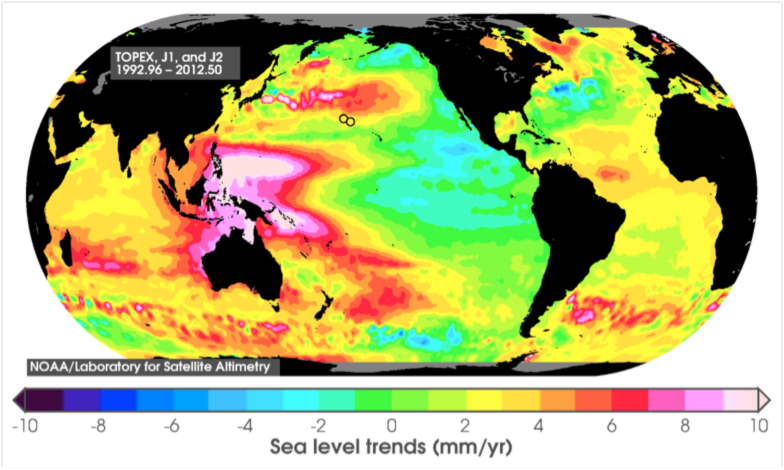5 December 2012
New model of sea level rise accounts for splash in the bath
Posted by kramsayer

Trends in sea level rise over the past decade. Northwestern Hawaiian Islands (circled) are in the splash zone. (Credit: Eric Leuliette, NOAA)
Vulnerable to Earth’s changing climate, people living on small, low-lying islands dread the day when rising seas will swallow up their homes for good. But new findings predict that some islands will become uninhabitable long before they’re submerged. Some island habitats will be destroyed up to 10 times faster than current models project, scientists reported Tuesday at the Fall Meeting of the American Geophysical Union.
“As the sea level goes up, you now have larger waves, and larger waves cause more run-up on the shore line,” said geologist and oceanographer Curt D. Storlazzi from the United States Geological Survey in Santa Cruz, Calif. Current predictions of land loss to ocean inundation are based on a “bathtub model,” which solely takes into account rising water levels rather than changes in ocean dynamics, he argues. These static models fail to consider the destructive effects of rising waves. “That’s the big thing these bathtub models don’t take into account,” Storlazzi said.
The ocean, of course, is nothing like placid bath water slowly filling a tub. To take the ocean’s rambunctious nature into account, Storlazzi and his colleagues created a new model of sea level rise that considers the effects of surging waves on the northwestern Hawaiian Islands—a string of low-lying islands and atolls extending beyond the more familiar southeastern chain..
When waves surge inland, they destroy fragile ecosystems for endangered or threatened nesting species. In the northwestern Hawaiian Islands, these fragile species include albatrosses, green sea turtles, and monk seals.
For humans that live on low-lying islands and atolls, the greatest threat posed by inundation is the fouling of fresh water on the island. “When you have over-wash events, suddenly you put salt water on top of fresh water, and you salinate the water,” explained Storlazzi.
He cited an example in 2008 when high surf ruined fresh water supplies on Roi Namur in the Marshall Islands. For six months, tankers of water and desalination equipment had to be hauled in to sustain the island’s inhabitants until rainfall brought down the salt concentrations to safe drinking levels.
An occasional over-wash event might not render an island uninhabitable, but these over-washes are expected to increase as sea levels rise, Storlazzi noted. Climate-driven changes in precipitation will also affect an island’s ability to cope with salty ocean inundations.
-Jessica Shugart is a science communication graduate student at the University of California, Santa Cruz.


 GeoSpace is a blog on Earth and space science, managed by AGU’s Public Information staff. The blog features posts by AGU writers and guest contributors on all sorts of relevant science topics, but with a focus on new research and geo and space sciences-related stories that are currently in the news.
GeoSpace is a blog on Earth and space science, managed by AGU’s Public Information staff. The blog features posts by AGU writers and guest contributors on all sorts of relevant science topics, but with a focus on new research and geo and space sciences-related stories that are currently in the news.